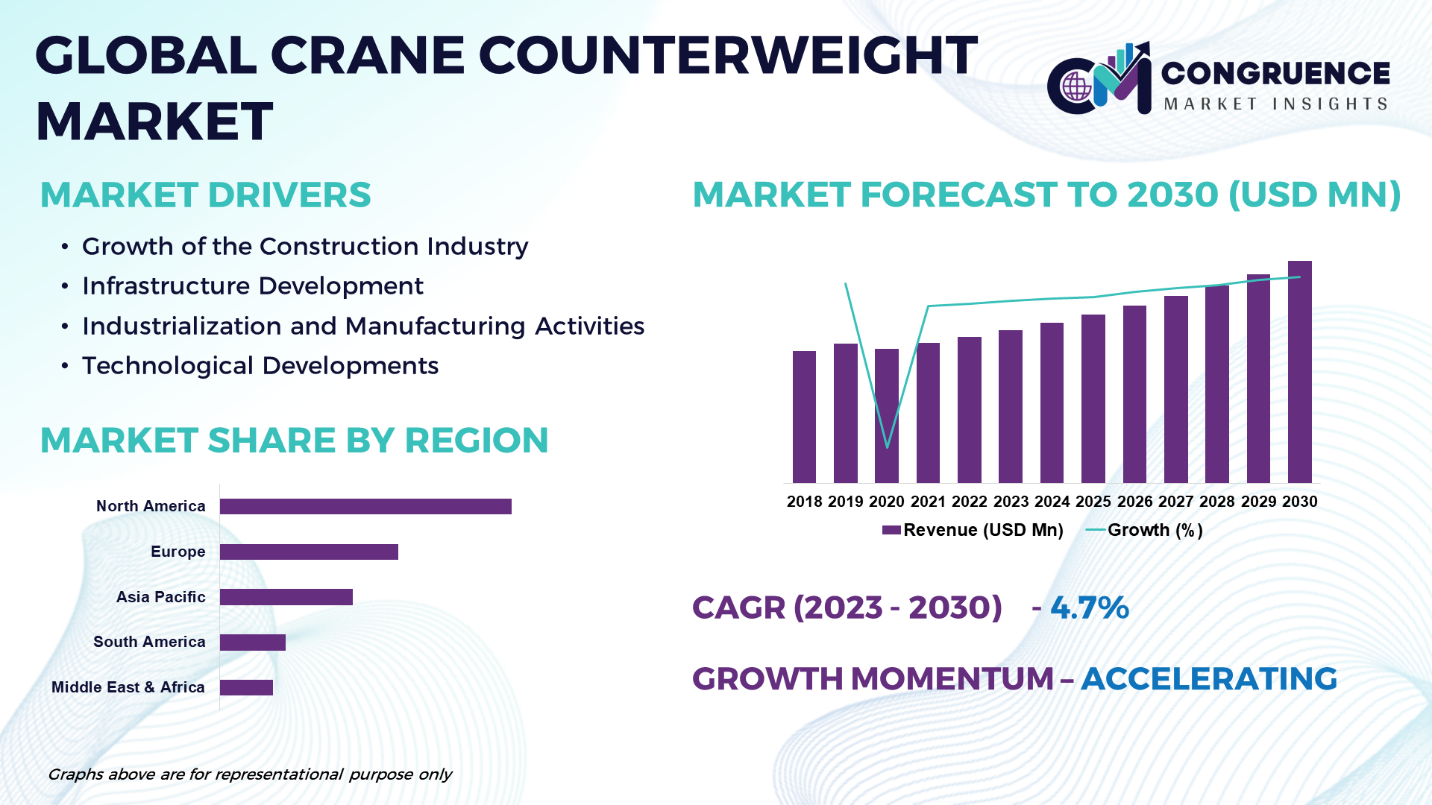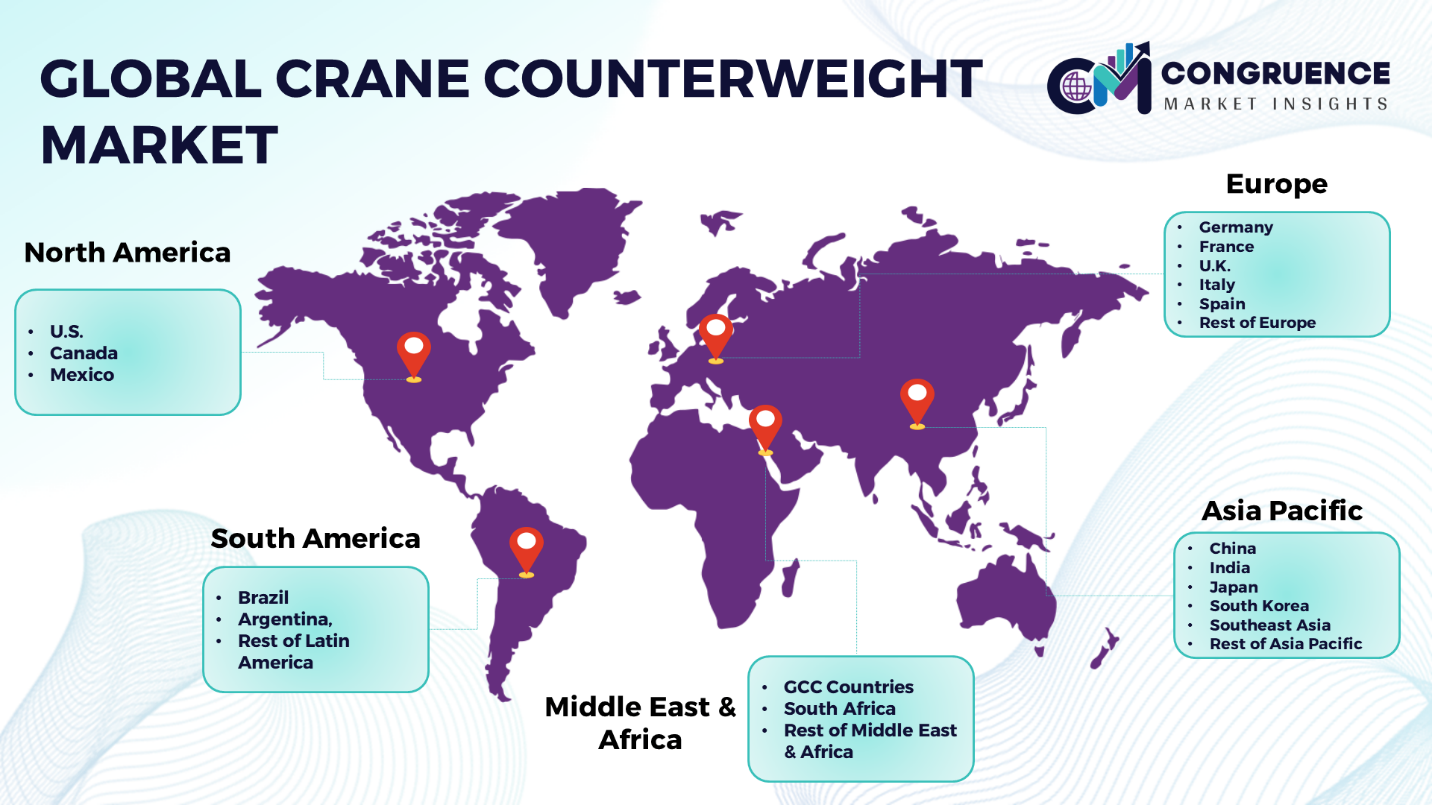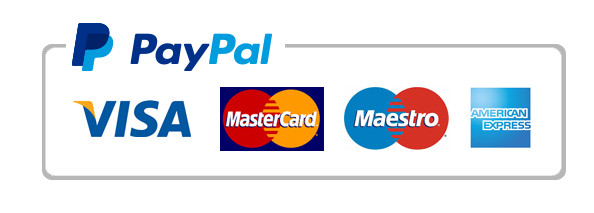Reports
The Global Crane Counterweight Market is expected to expand at a CAGR of 4.7% between 2023 and 2030. The provision of balance and stability to cranes during operations is a critical function of the worldwide crane counterweight market, particularly in the construction and heavy lifting sectors. Crane counterweights are crucial parts that are intended to balance the weight of the object being raised, guaranteeing secure and effective lifting operations. These counterweights' sizes and configurations vary based on the lifting capacity and application needs of the crane. Typically, they are constructed from materials such cast iron, steel, or concrete. The demand for infrastructure development and the ongoing global expansion of building activities will drive significant growth in the crane counterweight industry. Crane counterweight demand is driven by urbanization, industry, and the growing use of sophisticated lifting equipment. Furthermore, by improving the functionality and effectiveness of cranes, technical developments in crane design and manufacturing methods are further driving market expansion. The significance of superior crane counterweights in guaranteeing operational safety and efficiency cannot be emphasized, given the strict safety standards that control lifting operations and the requirement for accurate load management.

Crane Counterweight Market Major Driving Forces
Growth of the Construction Industry: One of the main factors driving the crane counterweight market is the growing construction industry, which is fueled by urbanization, industrialization, and infrastructure development projects. An increase in building activity makes the use of cranes necessary, which increases the need for counterweights.
Infrastructure Development: Heavy lifting machinery such as cranes are needed for infrastructure projects involving roads, bridges, airports, and commercial structures. Crane counterweights are becoming more and more in demand as governments over the world make investments in infrastructure development to promote economic growth.
Industrialization and Manufacturing Activities: Cranes are used in the industrial and manufacturing sectors for a variety of jobs, such as equipment installation and material handling. The need for cranes and crane counterweights is fueled by the growth of manufacturing facilities and industrial plants.
Technological Developments: As crane technology continues to progress, counterweight systems must also keep up with the development of larger capacity cranes and creative designs. The need for sophisticated counterweights made to meet the requirements of contemporary cranes is driven by increased crane performance and efficiency.
Crane Counterweight Market Key Opportunities
Emerging Markets: There are substantial market potential for crane counterweights in emerging economies due to the growing urbanization and infrastructural development in these regions. Counterweight demand is driven by rapidly industrializing and urbanizing countries, which present a large prospective market for crane and construction equipment.
Renewable Energy Sector: There are a lot of prospects for crane counterweights as a result of the increased attention being paid to renewable energy sources such as solar and wind power. Heavy lifting equipment is needed for construction and maintenance tasks in wind farms, solar parks, and other renewable energy projects, which increases the need for counterweights.
Technological Advancements: Manufacturers have the chance to profit from advancements in crane counterweight technology. Market expansion may be fueled by developments in materials science, such as the utilization of strong, lightweight materials, and design tweaks meant to increase counterweight efficacy and efficiency.
Crane Counterweight Market Key Trends
· Crane counterweights made of high-density materials, such as steel and tungsten, can reach greater weight-to-volume ratios.
· Increasing need for specialized counterweight arrangements made to fit particular crane models and lifting uses.
· Adoption of sensor-based and Internet of Things technology for predictive maintenance and real-time counterweight performance monitoring.
· Creation of lightweight counterweight systems to improve fuel economy and crane mobility.
· Preference for environmentally friendly counterweight materials and production techniques to lessen their influence on the environment.
· Crane counterweight rental and leasing options are becoming more and more popular as a cost-effective way to meet short-term project needs.
· Crane and counterweight safety can be improved by integrating cutting-edge safety features such as collision prevention technology and anti-sway systems.
· Automation and robotic systems integration for effective crane counterweight handling and installation.

Market Competition Landscape
Several major competitors and up-and-coming businesses fight for market dominance in the highly competitive worldwide crane counterweight industry, each using unique advantages and tactics to obtain a competitive edge. Well-known industry titans control the market thanks to their vast experience, presence throughout the world, and wide range of products. These businesses, especially in areas where there is a large need for construction and heavy lifting equipment, have a considerable market share and a well-established brand. Apart from prominent players in the sector, a plethora of smaller-scale producers and startups enhance the competitive environment by providing customized counterbalance solutions and cutting-edge technology. By concentrating on specialized markets or creating cutting-edge robotic systems for particular uses, these businesses disrupt established market dynamics and spur innovation. In the crane counterweight market, partnerships, collaborations, and strategic alliances between major players and technology providers are typical, allowing for the sharing of technologies and supporting initiatives for product development, market expansion, and technology exchange. Through these partnerships, cutting-edge technologies including IoT, AI, and sophisticated materials are frequently included into counterweight systems to improve their efficiency, dependability, and performance. Prominent players in the market include:
· American Crane & Equipment Corporation
· Tokyo Rope Mfg. Co., Ltd.
· O'Brien Lifting Solutions Inc.
· Konecranes Plc
· Manitowoc Cranes
· Kito Corporation
· Columbus McKinnon Corporation
· Liebherr Group
· Terex Corporation
· XCMG Group
· Tadano Ltd.
· Palfinger AG
· Sennebogen Maschinenfabrik GmbH
· SANY Group
· Cargotec Corporation
|
Report Attribute/Metric |
Details |
|
Base Year |
2022 |
|
Forecast Period |
2023 – 2030 |
|
Historical Data |
2018 to 2022 |
|
Forecast Unit |
Value (US$ Mn) |
|
Key Report Deliverable |
Revenue Forecast, Growth Trends, Market Dynamics, Segmental Overview, Regional and Country-wise Analysis, Competition Landscape |
|
Segments Covered |
· By Counterweight Material (Concrete, Steel, Cast Iron, Others) · By Crane Type (Mobile Cranes, Tower Cranes, Crawler Cranes, Others) · By Application (Construction, Mining, Oil & Gas, Marine & Offshore, Others) · By End-user (Residential, Commercial, Industrial) |
|
Geographies Covered |
North America: U.S., Canada and Mexico Europe: Germany, France, U.K., Italy, Spain, and Rest of Europe Asia Pacific: China, India, Japan, South Korea, Southeast Asia, and Rest of Asia Pacific South America: Brazil, Argentina, and Rest of Latin America Middle East & Africa: GCC Countries, South Africa, and Rest of Middle East & Africa |
|
Key Players Analyzed |
American Crane & Equipment Corporation, Tokyo Rope Mfg. Co., Ltd., O'Brien Lifting Solutions Inc., Konecranes Plc, Manitowoc Cranes, Kito Corporation, Columbus McKinnon Corporation, Liebherr Group, Terex Corporation, XCMG Group, Tadano Ltd., Palfinger AG, Sennebogen Maschinenfabrik GmbH, SANY Group, Cargotec Corporation |
|
Customization & Pricing |
Available on Request (10% Customization is Free) |
